The Sapphire R9 280X Toxic Review
by Ryan Smith on October 10, 2013 8:00 AM EST- Posted in
- GPUs
- Radeon
- Sapphire
- Tahiti
- Radeon 200
Power, Temperature, & Noise
Having seen the gaming performance of the 280X Toxic, let’s move on to power, temperature, and noise to get a better look at the performance characteristics of Sapphire’s Tri-X cooler. This will also give us a chance to evaluate the costs of Sapphire’s significant factory overclock with respect to power consumption.
| Radeon 280X Series Voltages | ||||||
| Sapphire 280X Boost Voltage | Sapphire 280X Base Voltage | Asus 280X Boost Voltage | XFX 280X Boost Voltage | Ref 7970GE Boost Voltage | ||
| 1.263v | 1.2v | 1.2v | 1.2v | 1.218 | ||
At the base GPU clockspeed of 1110MHz Sapphire is able to stick to 1.2v for their GPU voltage, but to boost up to 1150MHz they have to go to 1.256v. This is high for a Tahiti chip, and although still in the safe zone for something with this large an air cooler it is reaching about as high as we like to take Tahiti while maintaining longevity.
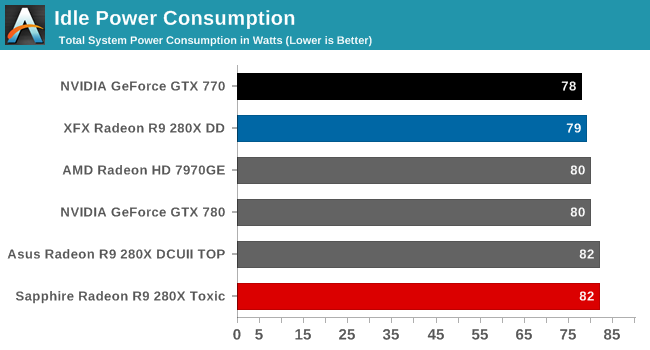
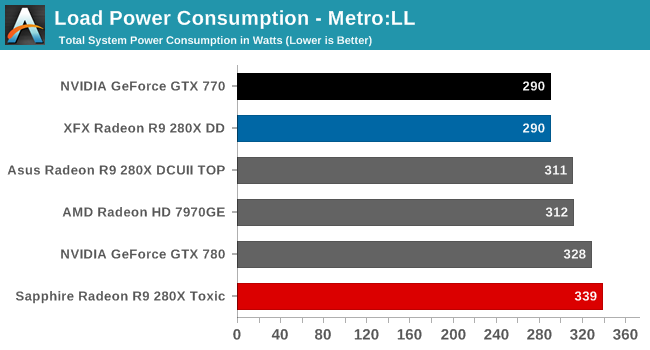
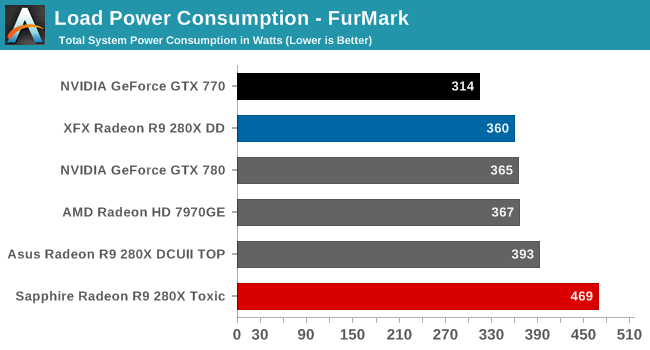
With the increased clockspeeds and voltages, rather expectedly we see an increase in power consumption. 339W (at the wall) under Metro is nearly 50W more than the stock 280X, and still 28W more than the overclocked (but not overvolted) Asus card. In fact it’s more than even the GTX 780, a card that still beats the 280X Toxic in our benchmarks.
FurMark shows a similar trend, with the 280X Toxic sustaining a load over 100W more than the stock 280X, or the GTX 780 for that matter. Sapphire has clearly set the PowerTune limit on their card higher in compensation for the amount of power a higher clocked, higher voltage GPU will take, and they have the cooling to back it up, letting the card draw this much power and sustain it. FurMark is a pathological case and gaming power consumption will be much closer to the Metro scenario, but it does show how high the Sapphire card can go under extreme load.
Consequently it’s clear that Sapphire has regressed some on the power curve to hit their performance targets. 1150MHz is unquestionably outside Tahiti’s sweet spot, so there is a significant power penalty to pay to get there.
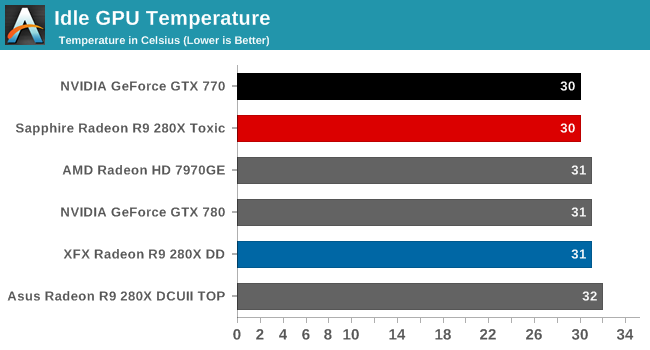
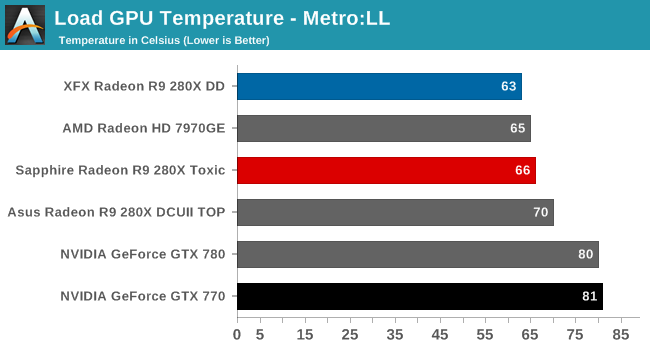

Considering the power numbers we just saw, Sapphire’s Tri-X cooler is earning its keep and then some. 66C under Metro is doing quite well for an open air cooled card drawing this much power, and the fact that FurMark temperatures only go to 75C despite the extreme power load there only further proves that the Tri-X cooler is up to the task for the Toxic. In spite of the high power draw, the card will have no trouble keeping up.
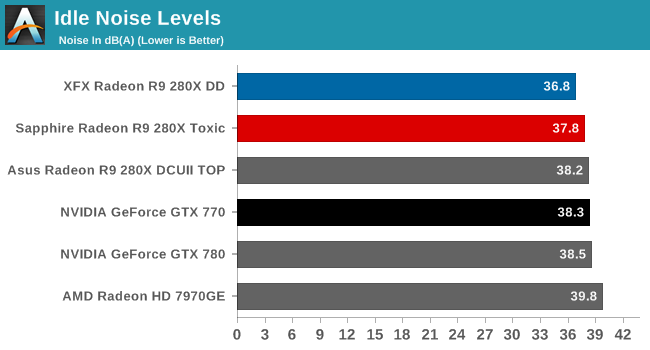
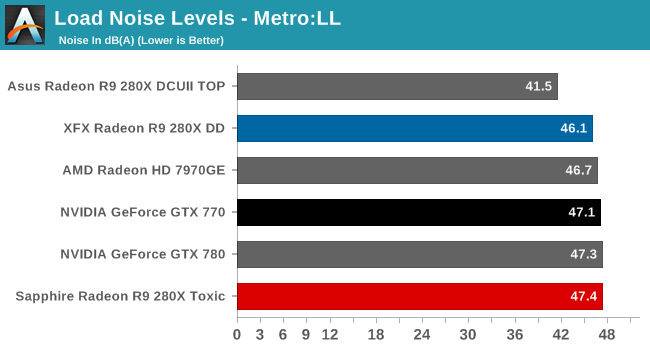
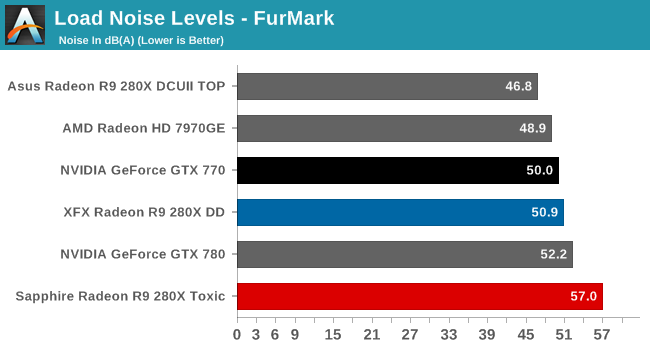
Finally our look at noise is something of a mixed bag for the 280X Toxic. The noise levels under Metro aren’t bad, but they’re also not great. At first glance Sapphire’s fan curve may be a bit aggressive, which is why we have 66C temperatures next to a 47dB(A) noise level. Next to the stock-clocked XFX card that’s a negligible increase in noise for a 13% performance increase, but the Asus card is something of a spoiler here. Asus in comparison gave up some cooling performance in exchange for lower noise levels and it shows. Sapphire could likely stand to be a bit less aggressive on cooling and bring those noise levels down, at least going by the conditions and results in our testbed.
FurMark on the other hand is outright loud, again going back to just how much power this card can draw when given a pathological use case and allowed to run free. I’m not sure if Sapphire could get away with a less aggressive fan curve here given the 75C temperature that goes with this noise level. Our testing methodologies don’t capture noise levels for other games, but based on our testing experience I don’t expect the card to get anywhere close to this under any game load, as those have always reflected what we see with Metro. Distributed computing/Bitcoin users likely wouldn’t be happy with this card though.
Ultimately Sapphire’s Tri-X cooler performs well under load here for typical workloads, and at least can easily keep up with the Toxic’s high power consumption under extreme workloads. The mixed results here ultimately come down to power consumption rather than the cooler itself.










84 Comments
View All Comments
marc1000 - Thursday, October 10, 2013 - link
wow, really nice factory OC there, I liked the cooler performance! still waiting fot 290/290x to show up... I bet we will have "non-X" versions of the smaller cards too, but launched a few months from now.anyway, this is mostly just curiosity. I just purchased one GTX660 (non-TI) as it is the fastest card with just 1 PCIe power connector, and I believe this keeps noise and heat manageable with smaller cases for casual gaming.
ShieTar - Thursday, October 10, 2013 - link
Technically, the 660Ti has a TDP and should also run perfectly well with a single connector. I think it only comes with 2 connectors to provide a bit of security versus bad PSUs, or in order to give you a little head room for overclocking. But yeah, for casual gaming the 660 gives the best price-performance ratio for anybody who needs more than iGPU performance.Of course the fastest card within a 150TDP would be an underclocked and/or undervolted Titan.
marc1000 - Thursday, October 10, 2013 - link
yeah, the hd7870 also seems to eat the same amount of power than gtx660, but also has 2 connectors for "safety". too bad nothing changed in 150wTDP world with this new re-spin of products - we will have to wait for 20 or 14nm for that. not a problem for me :)The Von Matrices - Thursday, October 10, 2013 - link
Since when is having an 80mm fan surrounded by two 90mm fans "asymmetric." That's the very definition of symmetry. Asymmetry would be if the 80mm fan was on one side of the card and the 90mm fans were in the other two places.piroroadkill - Thursday, October 10, 2013 - link
Fact.treeroy - Thursday, October 10, 2013 - link
The Asus is more expensive and is notably slower, and I don't have to worry about overclocking with the Sapphire.I wonder which one I'll buy.
Nice review by the way - glad to see a review of this card at last, this one hasn't got a lot of coverage but it's the one I've been eyeing.
Skiddywinks - Thursday, October 10, 2013 - link
What? The Asus is $40 cheaper.treeroy - Thursday, October 10, 2013 - link
Here in the UK, the Sapphire card is $430 and the Asus one is $440 [USD]Skiddywinks - Thursday, October 10, 2013 - link
I'm actually in the UK myself and assumed you were a Yank. My bad. Where are those prices btw, cause I am looking to upgrade my GPU and these 280X are tempting as sin itself.treeroy - Thursday, October 10, 2013 - link
Those are on Overclockers UK - http://www.overclockers.co.uk/search_results.php?k...I can't find many places selling the cards, but OCUK was the cheapest of what I saw.